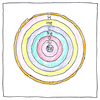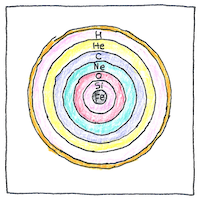Arthur Eddington, Hans Bethe, Carl Friedrich
von Weizsäcker, Ejnar
Hertzsprung, Henry
Norris Russell
astronomy

|
Stellar evolution
How any matter in space remains separate is a question, but no matter. If they aren’t flying away too fast, molecules in space attract each other and accumulate and as they accumulate the accumulated mass collapses, and as it collapses, the heat, pressure, and rotation of the accumulated mass increases. Its evolution depends on how massive it is. If it has less than eight percent of the mass of the Sun, it never starts burning by hydrogen fusion and becomes a brown dwarf or a planet. If it is massive enough for its core to heat up to over one hundred million Kelvin, hydrogen fuses, producing helium and heat, and pressure from this can balance the gravitational pressure so that it remains stable for a long time— billions of years. When a star burns up all its hydrogen, it collapses further, gets even hotter, and begins to burn by helium fusion— at least if it is massive enough. Nuclear fusion happens at first in the core of a mid-sized star. If it is less than half the size of the Sun, convection counteracts the tendency of heavier elements, as they are created by fusion, to sink toward the center. If it is bigger than one and a half times the Sun, convection occurs only in the center. Otherwise, as heavier elements sink, nuclear fusion happens in outer shells. —Got that?
Stellar scientists
Arthur Eddington Hans Bethe Carl Friedrich von Weizsäcker Ejnar Hertzsprung Henry Norris Russell Subrahmanyan Chandrasekhar
My star
A few stars peek through the night sky, cloudy and lit up by lights on the street. If I knew which one was my guiding star, things down here might seem more complete. Maybe I could rely on my star in the sky. Maybe it would act as a beacon or lighthouse to lure or to warn me from drifting near the rocks. You never know, my star might be a brown dwarf, or it might become a black dwarf, or a neutron star destined to explode as a supernova, or a black hole that will draw in everything including light. In the real world, in which I live and dream, fantasies are not as simple as in fairy tales.



Eddington proposed that hydrogen fusion powers stars; that is, it powers what are called “main sequence” stars. Bethe and von Weizsäcker provided the math for the fusion process, showing that stars release heat according to E = mc2. Hertzsprung and Russel graphed the brightness and temperature of stars, showing their normal life-cycles. The eventual states of some stars is speculative because the age of the observable universe is shorter than the time it should take for them to reach these states.
Eventually, when a star burns up all its fuel, it becomes a white or black dwarf, a neutron star, or a black hole; however, this part of the theory was not completed until the brilliant Subrahmanyan Chandrasekhar published his doctoral work in 1931.
See also in The book of science:
Readings in wikipedia: